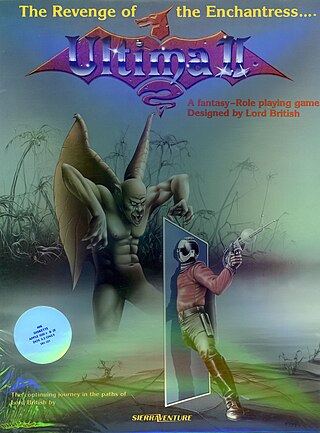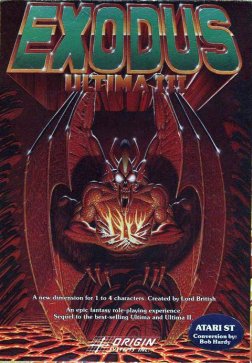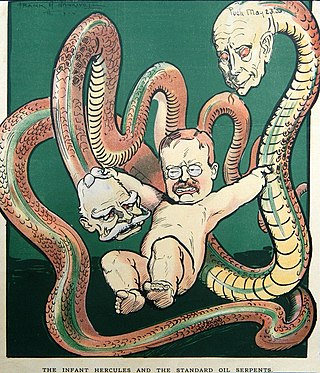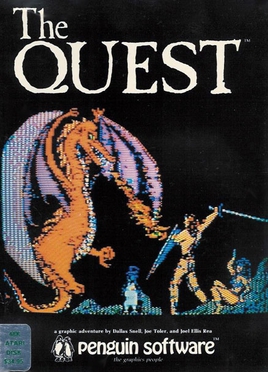
The Fantasy Trip (TFT) is a fantasy tabletop role-playing game designed by Steve Jackson and published in segments by Metagaming Concepts starting in 1977 and culminating in 1980. In 2019, Steve Jackson Games republished it as The Fantasy Trip Legacy Edition.

Suspended: A Cryogenic Nightmare is an interactive fiction video game written by Michael Berlyn and published by Infocom in 1983. Infocom's sixth game, it was released for Amstrad CPC, Apple II, Atari 8-bit computers, Commodore 64, Commodore Plus/4, IBM PC compatibles, TRS-80, and TI-99/4A. It was later available for Mac, Amiga, and Atari ST.

Star Raiders is a space combat simulator video game created by Doug Neubauer and published in 1980 by Atari, Inc. Originally released for the Atari 400/800 computers, Star Raiders was later ported to the Atari 2600, Atari 5200, and Atari ST. The player assumes the role of a starship fighter pilot, who must protect starbases from invading forces called Zylons. Piloting and combat are shown in the 3D cockpit view, while a 2D galactic map shows the state of the Zylon invasion. Neubauer made the game in his spare time at Atari, inspired by contemporary media such as Battlestar Galactica and Star Wars, as well as the 1971 mainframe game Star Trek.

Adventure Construction Set (ACS) is a game creation system written by Stuart Smith that is used to construct tile-based graphical adventure games. ACS was published by Electronic Arts in 1984 for the Commodore 64, then for the Apple II, Amiga, and MS-DOS. Smith previously developed several commercial adventure games of a similar style, such as Ali Baba and the Forty Thieves (1981).

B.C.'s Quest for Tires is a horizontally scrolling video game designed by Rick Banks and Michael Bate and published by Sierra On-Line in 1983. Versions were released for the Commodore 64, IBM PC, Atari 8-bit computers, ColecoVision, ZX Spectrum, MSX, and Apple II. Based on the comic strip B.C. by Johnny Hart, BC's Quest for Tires is similar to Irem's Moon Patrol from the previous year. A wheel-riding caveman is always moving forward through horizontally scrolling levels, and the player jumps or ducks as obstacles approach. The game's title is a play on the contemporaneous film Quest for Fire.

"Ali Baba and the Forty Thieves" is a folk tale in Arabic added to the One Thousand and One Nights in the 18th century by its French translator Antoine Galland, who heard it from Syrian storyteller Hanna Diyab. As one of the most popular Arabian Nights tales, it has been widely retold and performed in many media across the world, especially for children.

Ultima II: The Revenge of the Enchantress, released on August 24, 1982, for the Apple II, is the second role-playing video game in the Ultima series, and the second installment in Ultima's "Age of Darkness" trilogy.

Ultima III: Exodus is the third game in the series of Ultima role-playing video games. Exodus is also the name of the game's principal antagonist. It is the final installment in the "Age of Darkness" trilogy. Released in 1983, it was the first Ultima game published by Origin Systems. Originally developed for the Apple II, Exodus was eventually ported to 13 other platforms, including a NES/Famicom remake.

Dragonstomper is a video game developed by Stephen Landrum for the Atari Video Computer System and released by Starpath. The game follows the adventures of a dragon hunter who is given a quest by the king to defeat a dragon and reclaim a magical amulet that was stolen. The player makes their way over the countryside, vanquishing various adversaries and gaining gold and experience. After achieving enough strength, the player can enter a shop in an oppressed village where equipment can be purchased, soldiers hired, and special scrolls obtained to defeat the dragon in its lair.

Infidel is an interactive fiction video game published by Infocom in 1983. It was written and designed by Michael Berlyn and Patricia Fogleman, and was the first in the "Tales of Adventure" line. It was released for the Amstrad CPC, Apple II, Atari 8-bit computers, Commodore 64, IBM PC compatibles, TRS-80, and TI-99/4A. Ports were later published for Mac, Atari ST, and Amiga. Infidel is Infocom's tenth game.

Shamus is a shooter with light action-adventure game elements written by Cathryn Mataga and published by Synapse Software. The original Atari 8-bit computer version was released on disk and tape in 1982. According to Synapse co-founder Ihor Wolosenko, Shamus made the company famous by giving it a reputation for quality. "Funeral March of a Marionette", the theme song from Alfred Hitchcock Presents, plays on the title screen.

Wizardry III: Legacy of Llylgamyn is the third scenario in the Wizardry series of role-playing video games. It was published in 1983 by Sir-Tech.

Hi-Res Adventure #6: The Dark Crystal is a graphic adventure game based on Jim Henson's 1982 fantasy film, The Dark Crystal. The game was designed by Roberta Williams and was the first Hi-Res Adventure directly released under the SierraVenture label in 1983. Versions were published for the Apple II and Atari 8-bit computers. An alternate version of the game intended for younger players called Gelfling Adventure was released in 1984.

Gateway to Apshai is an action-adventure game for the Commodore 64, ColecoVision and Atari 8-bit computers. It was developed by The Connelley Group and published by Epyx in 1983 as a prequel to Temple of Apshai. It is a more action-oriented version of Temple of Apshai, with smoother and faster graphics, streamlined controls, fewer role-playing video game elements, and fewer room descriptions.

Murder on the Zinderneuf is a video game designed by Jon Freeman and Paul Reiche III and one of the first six games published by Electronic Arts in 1983. It was developed for the Apple II, Commodore 64, Atari 8-bit computers, and IBM PC.

Heracles, also known as Hercules, is a Greek and Roman mythological hero known for his strength and far-ranging adventures. He is one of the most commonly portrayed figures from classical mythology in the popular culture of the 20th and 21st centuries.
Quality Software is a defunct American software developer and publisher which created games, business software, and development tools for the Exidy Sorcerer, Apple II, and Atari 8-bit computers in the late 1970s and early 1980s. Asteroids in Space, written by programmer Bruce Wallace, was voted one of the most popular games of 1978-80 by Softalk magazine.

Ali Baba and the Forty Thieves is dungeon crawl role-playing video game written by Stuart Smith for the Atari 8-bit computers and published by Quality Software 1981. An Apple II version was released in 1982, followed by ports for the FM-7 and the PC-8800 series in 1985. It is the second of four role playing games written by Smith, following Fracas, and preceding The Return of Heracles and Adventure Construction Set.

The Quest is a graphic fantasy text adventure released in 1983 by Penguin Software. It was designed by Dallas Snell for the Apple II and was ported to the Atari 8-bit computers, Commodore 64, MS-DOS, and Mac.
Ali Baba and the Forty Thieves is a folk tale about Ali Baba, a character from Arabian literature.


















